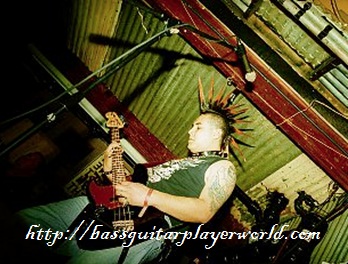Two Octave Playing Exercises to Help You Get a Feel
 Spicing up your playing isn’t always easy. After a while, you simply run out of ideas on how to improvise on bass guitar. That’s when it is best to go back to your roots and use the basics.
Spicing up your playing isn’t always easy. After a while, you simply run out of ideas on how to improvise on bass guitar. That’s when it is best to go back to your roots and use the basics.
Octaves are one of the most basic principles in music. They not only have great feel, but they are huge. Octaves can add a large amount of depth to a small piece of music without much work.
In this article, we will go over some basic octave playing exercises that will allow you to get a feel for your octaves all over again.
Exercise One: Exploration
In order to play your octaves, you need to find your octaves. Try playing a scale. Did you know that if you move that scale up twelve frets, it is exactly the same? This is an octave. No matter what note you play, if you add twelve frets to it, you will come up with the exact same note.
Some musicians like to remember this by considering the twelfth fret the second “open note” of the neck. The twelfth fret signifies that you are indeed starting all the way back at the beginning again. This means that if you play an open E, adding twelve frets (zero plus twelve equals twelve) will bring you to another E.
Try moving all of your scales up twelve frets. Get a feel for them in this new position. Try to familiarize yourself with playing the same exact scale in a new octave. When it comes to improvising and writing riffs and solos, this will help you to expand upon your ideas.
Exercise Two: Reaching Octaves from the Root Position
 Knowing how to find your octave twelve frets away is great. But what if you want to incorporate an octave into a fast bass run?
Knowing how to find your octave twelve frets away is great. But what if you want to incorporate an octave into a fast bass run?
Jumping up twelve frets isn’t going to make it easy.
Finding the octave in root position is a great exercise that will allow you to stay close, yet keep your octaves in mind at all times. All strings have an octave to strings away. For a four string bass, this applies to your E and A strings. For a five string bass, this applies to your B and E and A strings.
Your octave will always be, in standard tuning, two or three frets away at two string’s distance. This means that Your octave of open E will be the second fret of D, creating another E.
If you were to fret the third fret of your E string to get G, your octave would be the fifth fret of your D string, creating G.
Try finding all of your octaves in root position. All octaves on the same string will be the same space away. This means that all octaves on the E string will be two frets away on the D string.
In the end, the best thing you can do to learn your octaves is to practice. Take your time to learn the notes of your fret board. This will make your job much easier. The more time you are willing to put in, the further you will go.
Transform Yourself From An Average Player Into a Competent Bassist
JamPlay has thousands of video lessons that are conveniently arranged in structured lesson sets. With high quality instructions from world renowned bassists, Jamplay is an unparalleled learning resource. Whatever your genre preferences, you’ll find something here to help you improve your current level of playing.
Related Articles
Comments are closed.





